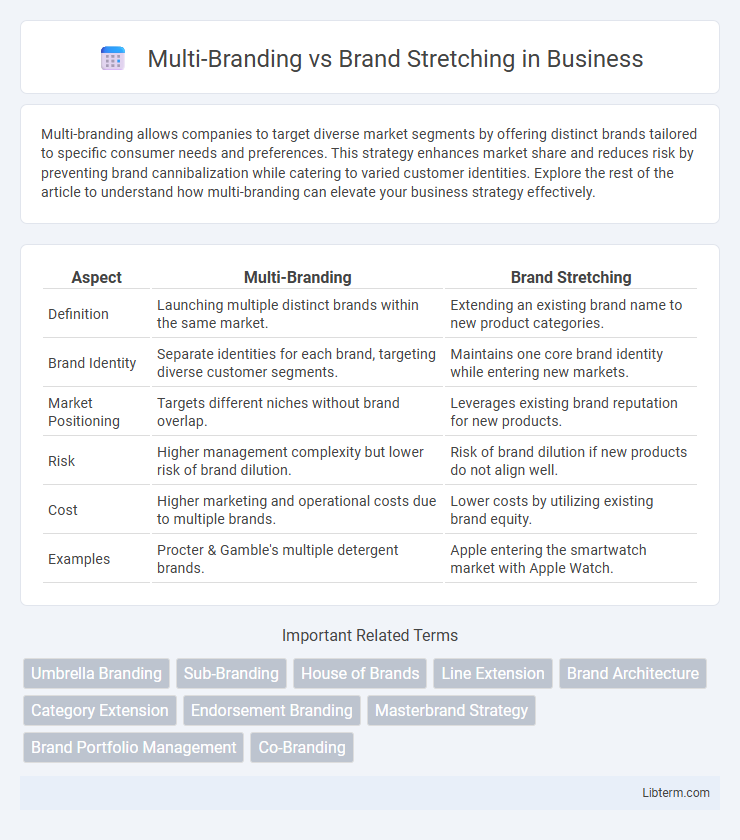Multi-branding allows companies to target diverse market segments by offering distinct brands tailored to specific consumer needs and preferences. This strategy enhances market share and reduces risk by preventing brand cannibalization while catering to varied customer identities. Explore the rest of the article to understand how multi-branding can elevate your business strategy effectively.
Table of Comparison
| Aspect | Multi-Branding | Brand Stretching |
|---|---|---|
| Definition | Launching multiple distinct brands within the same market. | Extending an existing brand name to new product categories. |
| Brand Identity | Separate identities for each brand, targeting diverse customer segments. | Maintains one core brand identity while entering new markets. |
| Market Positioning | Targets different niches without brand overlap. | Leverages existing brand reputation for new products. |
| Risk | Higher management complexity but lower risk of brand dilution. | Risk of brand dilution if new products do not align well. |
| Cost | Higher marketing and operational costs due to multiple brands. | Lower costs by utilizing existing brand equity. |
| Examples | Procter & Gamble's multiple detergent brands. | Apple entering the smartwatch market with Apple Watch. |
Understanding Multi-Branding: Definition and Key Features
Multi-branding involves a company marketing multiple distinct brands within the same product category to capture diverse consumer segments and reduce market risk. Key features include maintaining separate brand identities, targeted positioning, and differentiated value propositions to appeal to varied customer preferences. This strategy enhances market coverage and prevents brand dilution by keeping individual brands independent.
What is Brand Stretching? Core Concepts Explained
Brand stretching involves leveraging an established brand name to launch new products in different categories, aiming to capitalize on existing brand equity and consumer trust. This strategy expands brand presence without creating an entirely new brand, but it requires careful alignment between the brand's core values and the new product to avoid diluting brand identity. Successful brand stretching depends on strong brand recognition, relevant market fit, and consistent quality to maintain consumer loyalty across diversified offerings.
Strategic Objectives: Why Companies Choose Multi-Branding
Companies choose multi-branding to target diverse market segments and minimize risk by offering distinct products under separate brand identities. This strategy allows firms to capture a larger overall market share, tailor marketing efforts, and avoid brand dilution associated with extending a single brand across unrelated product categories. Multi-branding also enables competitive positioning by creating multiple brands within the same product category to cater to different consumer preferences and price points.
Goals Behind Brand Stretching: Unlocking Growth Potential
Brand stretching aims to leverage an established brand's equity to enter new product categories, unlocking growth potential by attracting a broader customer base without the high costs of brand development. This strategy enhances market presence and maximizes revenue streams by capitalizing on consumer trust and loyalty associated with the original brand. Effective brand stretching requires careful alignment with core brand values to maintain credibility and avoid dilution.
Advantages of Multi-Branding for Market Penetration
Multi-branding enables companies to capture diverse market segments by offering distinct products under separate brand names, enhancing consumer choice and reducing brand dilution. This strategy increases shelf space and visibility, improving competitive positioning and driving higher market share within target demographics. Multi-branding also allows firms to tailor marketing efforts to specific customer needs, fostering stronger brand loyalty and sustainable market penetration.
Risks and Challenges in Multi-Branding Strategies
Multi-branding strategies pose significant risks such as market cannibalization, where multiple brands from the same company compete for the same customer base, diluting overall market share. Managing diverse brand identities requires substantial investment in marketing and operational resources to ensure each brand maintains distinct consumer perception and avoids brand dilution. Additionally, conflicting brand messages may confuse consumers, weakening brand equity and complicating customer loyalty efforts.
Brand Stretching Success Factors and Pitfalls
Brand stretching succeeds when companies leverage strong brand equity to enter related product categories, ensuring consistency in brand values and maintaining quality standards to avoid consumer confusion. Key success factors include thorough market research, clear brand positioning, and alignment with core brand attributes, while pitfalls often involve brand dilution, loss of credibility, and mismatched customer expectations. Effective brand stretching balances innovation with the preservation of brand trust and relevance in target markets.
Consumer Perceptions: Multi-Branding vs Brand Stretching
Multi-branding enhances consumer perceptions by offering distinct brand identities tailored to diverse market segments, reducing the risk of brand dilution. In contrast, brand stretching can leverage existing brand equity to introduce new products but may confuse consumers if the extension deviates too far from the core brand promise. Effective multi-brand strategies foster brand loyalty through clear differentiation, whereas successful brand stretching depends on perceived relevance and consistency across product categories.
Case Studies: Real-World Examples of Each Approach
Multi-branding is exemplified by Procter & Gamble, which maintains distinct brands like Tide and Ariel to target different consumer segments without brand dilution, maximizing market share through specialization. Brand stretching is well demonstrated by Apple, which leverages its core brand equity to extend from computers into phones, tablets, and wearables, creating a cohesive ecosystem under a single brand umbrella. Both strategies show how companies align their brand architecture with market demands, optimizing customer loyalty and revenue growth.
Choosing the Right Approach: Multi-Branding or Brand Stretching?
Choosing the right approach between multi-branding and brand stretching depends on market segmentation and risk management strategies. Multi-branding allows companies to target diverse customer segments with distinct brand identities, reducing the risk of brand dilution. Brand stretching leverages an existing brand's equity to enter new product categories, optimizing marketing costs but requiring careful alignment to maintain brand integrity.
Multi-Branding Infographic

 libterm.com
libterm.com